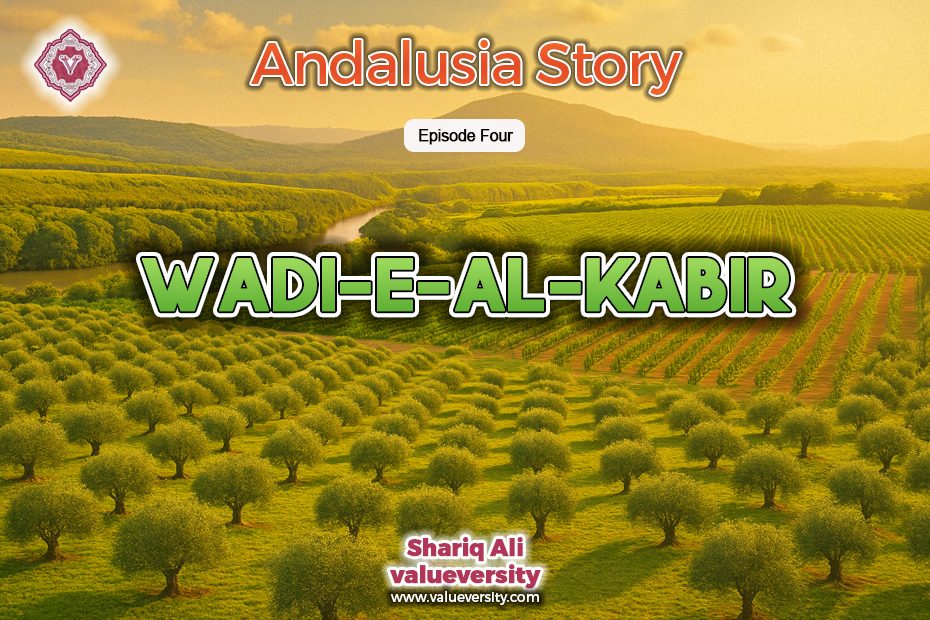Wadi-e-al-Kabir – An Andalusian Story (Episode 4)
By Shariq Ali
Valueversity
The coach had now departed from Carmona and was swiftly heading toward Córdoba. As we descended from the heights of the fortress into the lush green fields of Wadi-e-al-Kabir, we watched from the coach window as the gentle sunlight played hide-and-seek over the endless stretches of olive groves.
The coach cruised along a modern highway laid across the plains of Wadi-e-al-Kabir. Through its wide glass windows, the ripened olive harvest stretching far and wide was a sight to behold. Rows of green and black olive orchards lined the landscape, and in between, long rows of grapevines raced behind us — their arrangement so natural, as if nature itself had designed them to climb over bamboo trellises in that very fashion.
Looking over the waving fields of Wadi-e-al-Kabir, I whispered:
“Why don’t you tell me your story?”
I already knew this agricultural paradise was also a storyteller. The reply came:
“My story of glory begins in the year 755 CE, when the Umayyad prince Abdur Rahman Al-Dakhil fled from the East and arrived in Al-Andalus. It was in this very valley that he chose to forget his violent past and lay the foundation of a new dream. He was an extraordinary man — a figure of resolve, wisdom, and foresight. Arriving in this valley with nothing, he soon used his intelligence and strategic acumen to unite the supportive Umayyad tribes and set Al-Andalus on a path toward political stability, cultural refinement, and agricultural prosperity.
In 756 CE, he established an independent Umayyad state in Córdoba, politically autonomous from the Abbasid Caliphate. He made Córdoba his capital and transformed it into a center of knowledge, art, and civilization.
Historians call him Saqr-e-Quraish — the Falcon of Quraish — not only for his military brilliance and strategic skills but also for his unmatched contributions to the advancement of learning, arts, and culture.
Abdur Rahman and his successors introduced a modern irrigation system in Wadi-e-al-Kabir. They channeled water from the river into the fields through networks of canals, regulated its distribution with clear principles, and employed waterwheels known as Saqiya to irrigate the land effortlessly. They even appointed timekeepers (Muwaqqits) who used the position of the sun to advise farmers about the best times for irrigation.
This system and the resulting transformation were not confined to agriculture alone. The prosperity it generated sparked a cultural and civilizational revolution across the entire region.
The strategy behind this agricultural revolution was not merely to prevent water wastage — it also ensured social justice. Enhancing the land’s productivity became the first major step toward civilizational and cultural advancement.
Now, our coach was entering the outskirts of Córdoba city. Passing through newly built settlements and markets, we finally stopped in a narrow but beautiful street near the riverbank. Our guide signaled for us to disembark. We stepped out and formed a line, walking behind the guide. After about a hundred yards on foot, we stood before a grand, ancient, fortress-like gate. It was the Roman Gate. Standing directly in front of it was another guide waiting to receive us. A handover ceremony between guides took place here. The guide from Seville bid us farewell, saying, “Pedro is an expert in Córdoba’s history and the best guide for this city.”
The Roman Gate stood at the mouth of the historic bridge built over the river flowing before Córdoba. This was the only bridge through which caravans and travelers used to enter the city.
Pedro, our new guide and a historian of Córdoba, first told us about the Roman Gate’s historical background.
The current structure was actually built in the 16th century on the remnants of the Roman wall. Its present form is largely attributed to Renaissance architectural mastery. However, since its foundations date back to Roman times, it is still called the Roman Gate and the Roman Bridge.
Following Pedro on foot, we crossed the Roman Bridge and were now stepping into Córdoba — once the capital of Muslim Al-Andalus… To be continued.
